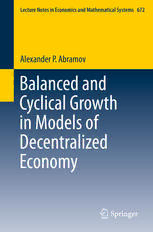
Balanced and Cyclical Growth in Models of Decentralized Economy PDF
Preview Balanced and Cyclical Growth in Models of Decentralized Economy
Lecture Notes in Economics and Mathematical Systems 672 Alexander P. Abramov Balanced and Cyclical Growth in Models of Decentralized Economy Lecture Notes in Economics and Mathematical Systems 672 FoundingEditors: M.Beckmann H.P.Künzi ManagingEditors: Prof.Dr.G.Fandel FachbereichWirtschaftswissenschaften FernuniversitätHagen Hagen,Germany Prof.Dr.W.Trockel MuratSertelInstituteforAdvancedEconomicResearch IstanbulBilgiUniversity Istanbul,Turkey and InstitutfürMathematischeWirtschaftsforschung(IMW) UniversitätBielefeld Bielefeld,Germany EditorialBoard: H.Dawid,D.Dimitrov,A.Gerber,C-J.Haake,C.Hofmann,T.Pfeiffer, R.Slowin´ski,W.H.M.Zijm Forfurthervolumes: http://www.springer.com/series/300 Alexander P. Abramov Balanced and Cyclical Growth in Models of Decentralized Economy 123 AlexanderP.Abramov DorodnicynComputingCentreofRAS RussianAcademyofSciences Moscow Russia ISSN0075-8442 ISSN2196-9957(electronic) ISBN978-3-319-07916-5 ISBN978-3-319-07917-2(eBook) DOI10.1007/978-3-319-07917-2 SpringerChamHeidelbergNewYorkDordrechtLondon LibraryofCongressControlNumber:2014944557 ©SpringerInternationalPublishingSwitzerland2014 Thisworkissubjecttocopyright.AllrightsarereservedbythePublisher,whetherthewholeorpartof thematerialisconcerned,specificallytherightsoftranslation,reprinting,reuseofillustrations,recitation, broadcasting,reproductiononmicrofilmsorinanyotherphysicalway,andtransmissionorinformation storageandretrieval,electronicadaptation,computersoftware,orbysimilarordissimilarmethodology nowknownorhereafterdeveloped.Exemptedfromthislegalreservationarebriefexcerptsinconnection with reviews or scholarly analysis or material supplied specifically for the purpose of being entered and executed on a computer system, for exclusive use by the purchaser of the work. Duplication of this publication or parts thereof is permitted only under the provisions of the Copyright Law of the Publisher’slocation,initscurrentversion,andpermissionforusemustalwaysbeobtainedfromSpringer. PermissionsforusemaybeobtainedthroughRightsLinkattheCopyrightClearanceCenter.Violations areliabletoprosecutionundertherespectiveCopyrightLaw. Theuseofgeneraldescriptivenames,registerednames,trademarks,servicemarks,etc.inthispublication doesnotimply,evenintheabsenceofaspecificstatement,thatsuchnamesareexemptfromtherelevant protectivelawsandregulationsandthereforefreeforgeneraluse. While the advice and information in this book are believed to be true and accurate at the date of publication,neithertheauthorsnortheeditorsnorthepublishercanacceptanylegalresponsibilityfor anyerrorsoromissionsthatmaybemade.Thepublishermakesnowarranty,expressorimplied,with respecttothematerialcontainedherein. Printedonacid-freepaper SpringerispartofSpringerScience+BusinessMedia(www.springer.com) To MyParents andto Anna,Nikolai,Denis,and Olga Preface Thisbookisdevotedtothemathematicalmodelingofthedynamicsofdecentralized economicsystems.Theauthorbecameinterestedinthistopicwhileanalyzinggov- ernmenteconomicregulationmethodsincountrieswithpredominantlycentralized management.Asitturnedout,insuchcountries,a significantpartofmanagement decisions related to economics is made at the local level. This can be explained by the fact that—contrary to what the authorities might wish for—any modern economy,beingaverycomplexsystem,cannotfunctioninasatisfactorywayunder totally centralized management. The range of products being enormous and the networkofproductionandconsumptionrelationsbeingextremelylarge,itissimply notpossibletomanageeverythingfromasinglecontrolcenter.Asaresult,evenin countriesthatemploytotalitariangovernmentmethods,partofeconomicdecisions aredelegatedtothelevelofindustrialsectorsoreventothelevelofenterprises. On the other hand, the complete economic autonomy of economic agents is a key propertyof any market economy.In the modern world, this type of economy has been embraced by most countries, which allows them—despite a number of problemsthatremainunresolved—tofurtherscientificandtechnologicaladvances andimprovethequalityoflifefortheirresidents.Atthesametime,intheauthor’s opinion,theimpactofthedecentralizedmanagementfactoroneconomicdynamics isyettoreceivedueattentionfromtheresearchcommunity. Thefieldrelatedtotheuseofmathematicalmethodsforstudyingdecentralized economic systems is extremely broad, but the author selected a relatively narrow subfield,onededicatedtotheexistenceofandreachingbalancedgrowthinmodels of systems that use Leontief technologies. A presentation of the results obtained while studying this subfield constitutes most of this book. However, the author remainedsomewhatunsatisfiedwithsomeoftheassumptionsmadewhilebuilding the models. An attempt was made to move the assumptions closer to the real economicworld.Intheresulting,modifiedmodels,someoftheeconomicindicators showedanasymptotictendencytocyclicity.Thisbooksalsocontainsananalysisof thedynamicsofthesemodels. It should be stressed that all the considered models are extremely simplified representationsofreal-worldeconomicprocesses.Nevertheless,theobtainedresults vii viii Preface allow the author to put forward the following bold hypothesis: Decentralized systemsshouldbeconsideredfromtheperspectiveofcyclicaldynamicsratherthan thatofbalancedgrowth. As noted above, modern economic systems are extremely complex. However, thehistoryofmathematicaleconomicstellsusthatsomeoftheaspectsofeconomic life can be studied successfully provided that an appropriate mathematical model is developed. The author hopes that this book will help draw the attention of the research community to the important topic of using mathematical methods for studyingthedynamicsofdecentralizedeconomicsystems. It is presumed that the reader is familiar with basic matrix analysis methods. Nevertheless, the book includes a brief overview of the propertiesof nonnegative matrices,whichcanbereferredtowhenreadingthemainchaptersofthebook. This book will be of interest to professionals studying the dynamic models of economic systems. It may also be of help to senior undergraduate students and graduatestudentsstudyingtheapplicationofmathematicalmethodsineconomics. TheauthorwouldliketothanktheRussianFoundationforBasicResearchforits financialsupport(projectsno.07-07-104,10-07-00286,and13-07-00730). Moscow,Russia AlexanderP.Abramov April2014 Contents 1 Introduction .................................................................. 1 References..................................................................... 6 2 BalancedGrowthinDecentralizedEconomies........................... 7 2.1 ModelDescription ...................................................... 8 2.2 PlanningBasedonProfitMaximization ............................... 15 2.3 PaymentBalancesofSectors........................................... 20 2.4 CounteractingDecreasesinProfit...................................... 23 2.5 PersonalizedPricesforConsumers .................................... 26 2.6 AveragePricesandPersonalizedDiscounts ........................... 33 2.7 GeneralizedPriceFormula ............................................. 36 References..................................................................... 40 3 TransitiontoBalancedGrowth............................................. 41 3.1 BasicAlgorithmforTransitiontoBalancedGrowth.................. 42 3.2 DynamicsofDualVariables............................................ 51 3.3 AutonomousEstimatesoftheExpansionRate........................ 54 3.4 Demand-BasedPlanning................................................ 57 3.5 ForwardandCurrentPlanning ......................................... 59 3.6 UnbalancedSupplyofResources ...................................... 61 3.7 AgreeingonEstimatesoftheExpansionRate......................... 68 3.8 TheBasicTransitionAlgorithmandtheMIMModel................. 72 References..................................................................... 78 4 TheFinanceoftheTransitionPhase....................................... 81 4.1 TransitiontoBalancedGrowthBasedonFinancialIndicators....... 82 4.2 TheDynamicsofBasePrices .......................................... 86 4.3 TheAsymptoticBehaviorofPaymentBalances ...................... 90 4.4 PaymentBalancesandSelf-Financing................................. 95 References..................................................................... 98 ix
